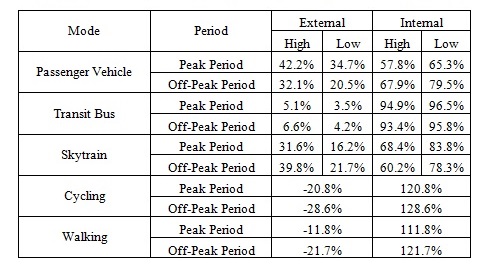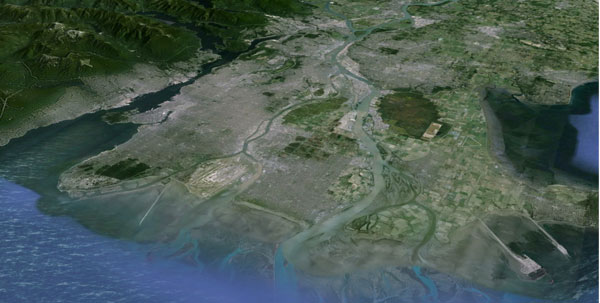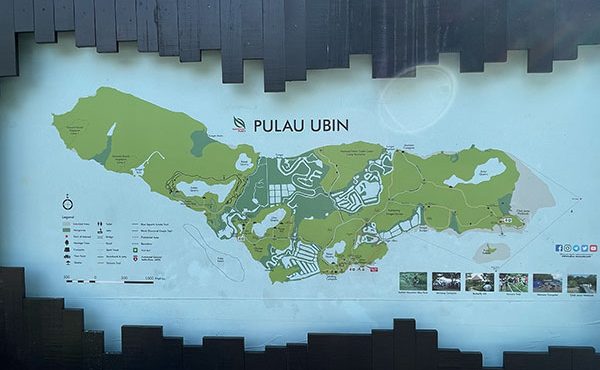
[EDITOR’S NOTE: We are please to offer our readers the fourth part of George Poulos’ in-depth series focusing on the Comprehensive Costs of Transportation and Metro Vancouver. If you missed past articles, you can read them here: Introduction, Part 1 – Costs and Benefits of Transportation in Vancouver (Part 1), Investing in Transit is Imperative for Metro Vancouver (Part 2), and The Business Case for Active Transportation (Part 3).]
One of the primary outcomes of full cost accounting studies is to demonstrate the true utility and impact of various modes of transportation. As discussed previously, total costs include both internal and external components. The presence of so-called hidden or external costs often means there are misconceptions about the relative costs of various modes of transportation – both to the user, and their general expense to society. Indeed, these perceptions often influence public opinion and even government policy, with regards to investments in transportation.
With that in mind, final unit costs illustrated in Table 1.0 may come as a surprise to some (although perhaps not to many others). Indeed, the resulting aggregate costs illustrated in Table 2.0 provide a more comprehensive picture of true transportation costs to society. In the interest of completeness, it should be mentioned that the list of cost items considered in my analysis (while checking many of the major boxes) are not exhaustive. A fuller assessment of transportation impacts in the future would consider such components as (though not limited to) parking costs, roadway and gas station land value costs, water pollution and hydrological impacts (from roadway water runoff), and waste disposal costs. We should therefore consider present results to be highly conservative (even in the “high case” scenarios illustrated in Tables 1.0 and 2.0).
Even still, with the information at hand it is illustrative to compare the personal costs of transportation by mode in relation to their impacts to society. The applications of such a comparison, in addition to considering total aggregate costs, can be put towards understanding the concept of “transportation equity”. This is a broad term which is comprised of the following series of indicators:
- Access to transportation alternatives – providing an equity of travel options
- Equity of investment – ensuring that various modes are allowed to develop
- User Equity – ensuring that users pay in proportion to their impacts
Taken together, these indicators are often strong predictors of transportation behaviors, statistics, and impacts. Generally, the more “equitable”, the more likely there are to be well developed travel options, balanced mode shares, and reduced transportation impacts. The first of these two indicators can be gleaned on the basis of observation, government policy, and public spending information.
However, to understand “user equity”, total transportation costs – such as those calculated in my analysis – are required. A first approximation can be made by comparing the proportion of total costs that are absorbed by the user in relation to external costs. This can be done by dividing the internal and external cost component of unit rates by total costs. As illustrated in Table 4.0. one can clearly see that fractions vary significantly between modes and a result of high or low external costs.

Although telling, a more complete picture can be made by comparing the total impacts to society by mode (i.e. total external costs) to amounts contributed to society by users (i.e. total charges). In other words, this represents the amount paid directly to society by users to utilize each mode of transportation compared to the subsequent impacts of their activity. Charges vary by mode – transit modes considered fare box payment (or alterative payment option), while charges for passenger vehicles included PST on vehicle finance, license and registration costs (including PST), PST on maintenance and repair, PST on tire costs, fuel taxes (the dedicated motor fuel tax, provincial motor fuel tax, carbon tax), the federal air conditioner tax from http://heatingairpros.com/riverside/, and the BC tire tax.
Note, there are additional sources of funding for transportation (among other things) in the way of general taxation. However, these are paid by all and are not set in proportion to personal transportation behavior. Results are illustrated in Table 5.0.

As can be seen from the Table, impacts versus charges are starkly contrasted. While Vancouver enjoys high transit ridership (which, therefore, makes these modes highly economical to society, and equitable owing to user payment), the very large external costs of driving are currently largely unremitted. This means that there is a large inequity with regards to user payment. This discrepancy has not been lost on economists, governments and industry professionals. In fact, it forms the very basis behind the notion of road pricing schemes, which have been proposed as a mechanism to promote transportation equity. While not a popular proposition in the eyes of many, the rationale behind road pricing schemes are sound:
- To redeem a part of the external costs of driving by internalizing them to the user (user equity);
- To price the use of roads commensurate with the utility it provides to users;
- To serve as a source of funding for high quality transportation alternatives (equity of investment).
One can understand the function of road pricing acting through these three mechanisms as a cycle. By valuing the costs of driving in proportion to its impacts, user perception and behavior would inevitably change. For example, a personal vehicle would be used only for those trips which the user deemed to merit the cost. This can be expected to reduce overall vehicle kilometres travelled (VKT).
Taken together with further VKT reductions stemming from improved management of trips by alternative modes (which would be funded to great effect by road pricing schemes, thereby increasing their utility), the relative utility of roads would actually increase. Why? Because less traffic on the roads would enable road users to actually exercise the primary utility of an automobile – the ability to travel at relatively high average speeds towards a personalized destination (just like in the commercials). As it stands now, anyone who has driven through Metro Vancouver will attest to the fact that at times, a large part of “driving” involves dancing the slow waltz.
In the end, road users would be paying a commensurate fee for an efficient and fast mode of transportation, in the same way that transit users currently pay a fare to access a broad system of travel, or for the utility of riding along an exclusive corridor at high speed. The alternative to this proposition can be drawn from our present day outlook– to retain roads that are highly variable – at times inoperable – continually degrading in level of service, yet ostensibly “free”.
All this considered, road pricing schemes are still a very delicate proposition. After all, they are intended to ameliorate unsustainable transportation behavior and investment practices, not to be a punitive measure for individuals without other alternatives. In reality, these schemes are largely feasible and successful in reducing VKT in areas that have already achieved a requisite level of transportation diversity (or are planning for it). Meaning, other high-quality options are, or will become available. This is why these schemes have been presently limited to city centres in many places.
Despite these considerations, it does not change the reality that driving has been made artificially cheap and this has created a gap between costs and charges that is undeniable. Left unabated, this gap will presage an eventual reckoning of costs that the Metro Region would do very well to avoid. This can be understood through the concept of transportation equity and the three indicators mentioned above (i.e. options, funding, and user payment). The reader can imagine this device acting as a positive feedback loop, fueled by transportation investment, subsequent demand and use, and ensuing impacts.
An inequitable and an equitable cycle can each be thought of as spinning in opposite directions – the former generating ever burgeoning costs, and the latter achieving stability in managing demand, user costs, and societal impacts. This is achieved as an outcome of many of the planning issues which weigh heavily on future of the region today – especially those places slated for development. These include the nature of transportation investments, the ability to secure funding for transit, and future development policies.
What this looks like is no mystery. Sprawling developments naturally engender a single track of transportation investment and an over-reliance on the personal vehicle (low investment equity). As a consequence, alternative modes are not developed (low equity of options), demand is not managed effectively, and traffic operations inevitable tend towards failure and a deterioration of livability standards (among a number of undesirable outcomes).
Once this cycle is established, it is a very difficult and long process to reverse. In fact using history as an indicator, past responses have been to double-down on the problem – wider roads and more diffuse development. This has always led to more VKT, less diversity, fewer effective travel options, and an unmitigated growth in external costs (round the cycle we go). All the while, there is no incentive to reduce VKT or for road users to remunerate the cost of their impacts (low user equity).
A different spin can be taken from the example of high density-mixed use developments, which make ideal candidates for alternative transportation modes (high equity of options). The prudent response from authorities (an excellent example has been the City of Vancouver) would be to prioritize and invest in multimodal transportation (high investment equity). If these devices succeed, trip making could be managed effectively and could allow the stabilizing effect of road pricing schemes to be put into effect (high user equity) and provide further funding for alternatives. The confluence of these events would not only further reduce per capita VKT, but would also proportionately reduce total transportation costs (both internal and external) across all modes.
In the face of many pressing planning issues, the concept of transportation equity represents yet another lens that we can use to evaluate the workings of the region’s transportation systems. In conjunction with the unit costs of transportation illustrated in Table 1.0, we can use the example of the City of Vancouver to gain an appreciation of what this looks like in numbers. To this end, we can place Vancouver in a cycle spinning in the right direction – yet along with the rest of the region, still beholden to the question of future “equity of investment”.
The above calculations also serve the important purpose of discussing the concept of road pricing – a topic which is still relatively new to the fore of regional discourse, already controversial, and guaranteed to gain more traction in the future. It is important to contextualize this issue within the larger framework of transportation equity and what that means for the region. After all, given what we know about future transportation demands, if it means contributing towards delivering the transit the region will need to manage it, implementing select road pricing schemes might not be as extreme as the consequences of not doing so.
Indeed, given the magnitude of yearly external costs contributed by passenger vehicles in Vancouver alone (see Table 2.0), one can only imagine how great this sum is across the entire region (likely several billion dollars). Even skimming across the top of this pot would provide a substantial yearly funding source that could mean the critical difference in securing the funding for the transit projects needed to keep the region moving.
Join us next Monday, when we explore new ways to asses the trade-offs of transportation projects…..
***
Just in case you missed earlier pieces of The Comprehensive Costs of Transportation and Metro Vancouver
- Introduction
- Part 1 – Costs and Benefits of Transportation in Vancouver
- Part 2 – Investing in Transit is Imperative for Metro Vancouver
- Part 3 – The Business Case for Active Transportation
**
George Poulos, EIT, MSCP is a transportation engineer-in-training as well as a recent Masters graduate of the School of Regional and Community Planning (SCARP) at UBC. He has previously worked for consulting engineers on a variety of transportation and municipal projects. Originally from Ontario, he currently lives in Vancouver.




